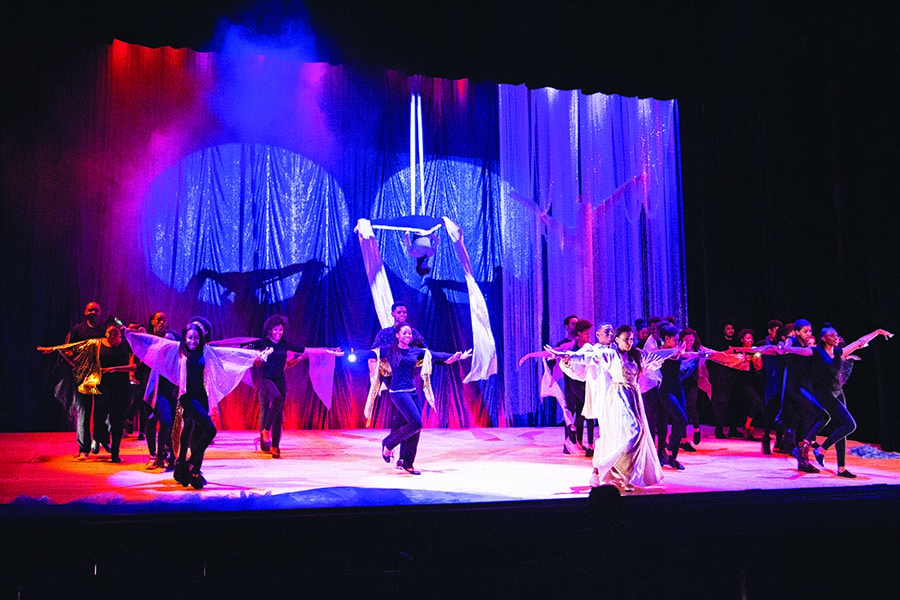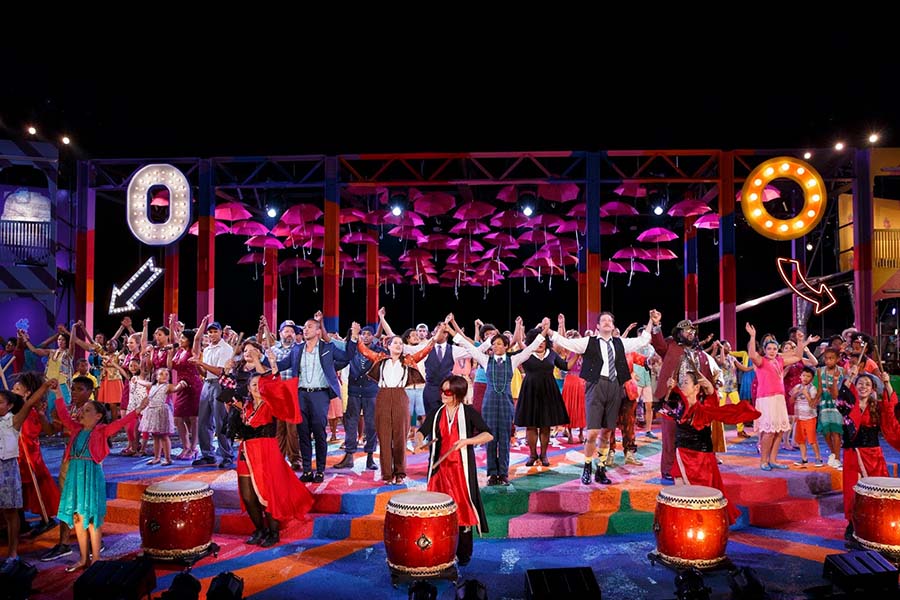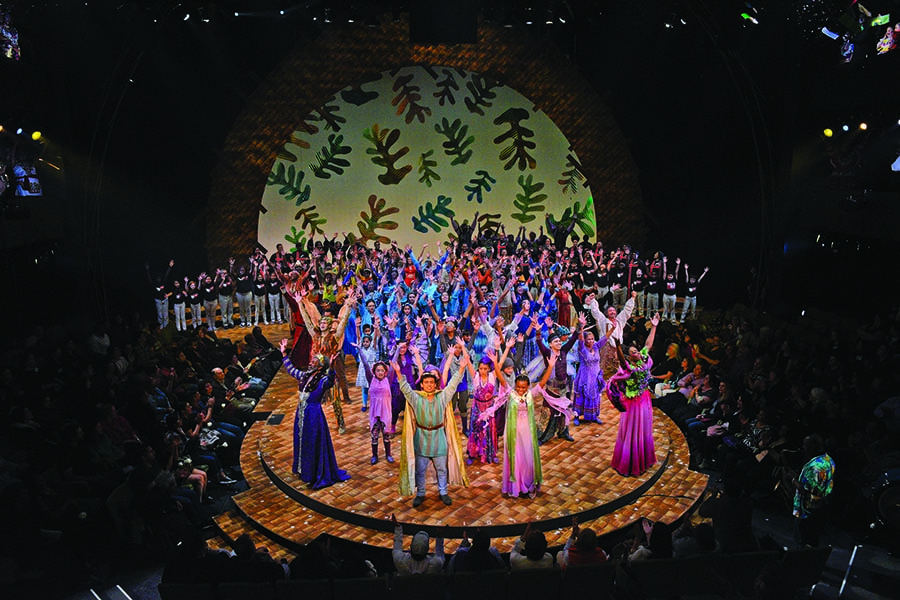The Public Works initiative was made possible in part by support from Theatre Communications Group's Audience (R)Evolution program.
Kevin Moriarty would like to start a new tradition. In less than a decade, the artistic director of Dallas Theater Center wants every theatre in America to be producing a Public Works show over Labor Day weekend.
“This has been one of the most terrifying and exhilarating, not to mention profoundly revolutionary, projects I’ve ever worked on,” Moriarty enthused roughly a week before DTC’s inaugural Public Works production, Shakespeare’s The Tempest, took the stage in March. “It is the greatest opportunity we have to change theatre on a national level.”
Public Works, developed in 2013 by Oskar Eustis and New York City’s Public Theater and still overseen by original director Lear deBessonet, is a community-based approach to theatre. But isn’t theatre inherently community-based, you ask? Well, it depends how you define “community”: It’s still true that U.S. theatre is largely made by and for a homogeneous, self-selecting group. Even the most inclusive theatres don’t tend to reflect or represent, let alone see the patronage of, anything like the full range of their local communities.
Enter Public Works: theatre that is truly of, by, and for the people.
The program was originally designed to work with partner organizations in the five boroughs of New York City, through which the Public invited various communities to participate in workshops, take classes, attend performances, and—most importantly—join in the creation of ambitious works of participatory theatre. These pageant-style productions, staged at the Delacorte Theater at the end of each Shakespeare in the Park season, incorporate both professional actors and community members to perform lively musical adaptations of classic works. For example, the inaugural production of The Tempest incorporated taiko drumming, Mexican folkloric dance, and a cameo from NYC’s Taxi Workers Alliance.
“Everyone is invited to this party,” said deBessonet in a 2015 statement from the Public, two years after Public Works had successfully taken off in New York. And she meant it.
Now theatres around the country have accepted the invitation, including DTC and Seattle Repertory Theatre. But Mosaic Youth Theatre of Detroit was the first to the party. The arts nonprofit, which serves hundreds of young people from more than 50 Detroit metro schools with theatrical and musical training, was selected by the Public in 2015 to pilot the community-based model outside of New York.
“A lot of our programming is collaborative in nature—we partner with organizations for the music and dance components of our shows—so it wasn’t difficult to involve even more community partners this time,” said Mosaic associate artistic director and director of music programs DeLashea Mya Strawder. “We already had a lot of these relationships established, so we were a natural fit.”
The Mosaic team met with Eustis and deBessonet to determine whether Todd Almond’s 90-minute, musicalized Tempest, first staged at the Delacorte in 2013, would be a good fit. Considering that a hallmark of all Public Works productions has been the abundance of roles for young cast members, the results leaned toward favorable. Mosaic’s Tempest was performed over one weekend in May 2015.
“Our actors are young people from high schools all over the metro area who may or may not have arts or music programs in their schools,” said Strawder. “We were considered along with organizations that had professional performers and much higher budgets, so there was a real sense of pride and accomplishment in understanding that the Public chose us. That did a great deal for not only our young actors’ self-esteem, but for the self-esteem of the entire community.”
Though Mosaic does not have plans to continue producing Public Works shows, the experience did establish a valuable partnership between the two theatres. A small group of students gets to spend a week in residence at the Public every year, engaging in workshops, watching productions, and connecting with theatre professionals. This year, three graduating seniors will partake in a more in-depth, three-week summer internship, shadowing artists and administrators in NYC.
“Working with the Public has taught our young artists not only about performing, but the importance of leadership skills that can be applied to any profession,” said Strawder. “It also lets us all embrace the conversation about diversity and inclusion in the arts leadership and production fields.”

Fast-forward to March 2017, when DTC presented Almond’s Tempest for four performances with a cast of more than 200 Dallasites. And Seattle Rep plans its own Public Works-style staging of Almond’s version of The Odyssey Sept. 8-10. (The two adaptations, as well as Almond’s adaptation of The Winter’s Tale, are licensed and can be produced nationwide via Theatrical Rights Worldwide, should other theatres decide they want in on the fun, though they’re under no obligation to do them as community collaborations.)
“The Public Works program has been a brilliant success here in New York, modeling what can happen when a theatre sets out to radically expand its relationship to the city which it serves,” said the Public Theater’s Eustis in a statement. This year the Public will mount Shaina Taub and Laurie Woolery’s adaptation of As You Like It for an unprecedented five nights, Sept. 1-5.
Deliberately blurring the line between professional artists and community members can be a challenge, but it’s one these theatres see as vital to helping the arts grow and adapt.
“The reward matches the risk,” said Marya Sea Kaminski, associate artistic director at Seattle Rep. “There is an incredible necessity for this work right now, both nationally and locally. We are all asking how we can focus on what connects us, rather than what divides us.” She paused, then said with conviction, “This is the most important thing I’ll do with my career, and I say that without hesitation.”
While Seattle Rep is preparing for its journey, DTC has already lived the experience. Public Works first came to Dallas thanks to Ignite/Art Dallas and the Southern Methodist University Meadows Prize, which was awarded to deBessonet in 2015 with the intention of bringing the program south. But this is not a one-off: Public Works will return to DTC in summer 2018 with The Winter’s Tale, this time as part of the company’s official season. Moriarty said he intends to keep producing Public Works shows as long as the program is available.
The Tempest opened up DTC to a community they’d historically underserved. Because the population of Dallas is 42 percent Latinx, that meant a sizable amount of the cast members of The Tempest were Spanish speakers—and some only spoke Spanish. “In my decade at DTC, we’ve never rehearsed in any language but English,” Moriarty admitted.
Translators were brought in to help communicate the wishes of director Moriarty, Broadway choreographer Ann Yee, and local music director Vonda K. Bowling. During the first few weeks of rehearsal, the already large cast size would swell daily, as family members tagged along to support children, parents, grandparents, and siblings. Warm-ups would start, whimsical portions of the play would be staged (the community cast largely portrayed water, sand, and air spirits), and then the stage manager would inform Moriarty that several more people had signed on.
“People walking by the Wyly Theatre could see us rehearsing through the windows,” recalled Moriarty, noting that the number of participants made it impossible to use a smaller, more traditional rehearsal space. “It wasn’t a normal sight to see all these people interacting. You had everyone from a 6-year-old kid to a 95-year-old woman coming together over Shakespeare.”
The diverse ensemble came courtesy of five community organizations: Bachman Lake Together, City of Dallas Parks and Recreation, Jubilee Park and Community Center, Literacy Instruction for Texas, and Vickery Meadow Learning Center. Cameos were also made by Rickie Rush’s Living Sound Choir from Inspiring Body of Christ Church, Dark Circles Contemporary Dance, Townview High School Big D Drumline, Anita N. Martinez Ballet Folklorico, Northlake Children’s Chorus, Inner City All-Stars Brass Band, Mitotiliztli Yaoyollohtli Aztec Dancers, and rapper/singer Sam Lao. Local celebrities Mayor Mike Rawlings, Councilman Adam Medrano, and “voice of the Dallas Cowboys” Brad Sham alternated in the role of the wedding officiant. Whew!
The non-professional actors were supplemented by five pros: Tony nominee André De Shields, local performer Rodney Garza, and DTC company members Ace Anderson, Liz Mikel, and Alex Organ.
Tempest’s otherworldly qualities made it an ideal basis for this wholly unconventional show. The drum line pounded as the storm that shipwrecked Antonio and Alonsa (several characters were cast against their traditional gender), while the Aztec dancers—and their giant feathered headdresses—thoroughly disoriented Gonzalo and his tribe. Once Ferdinand and Miranda pledged their love, the party got started with an on-your-feet, everybody-dance mini-concert from rapper/singer Sam Lao, who only days before had opened for hometown girl Erykah Badu.
“It was important to me that this play not be excepted from the artistic work that we do,” said Moriarty. “This is not simply an outreach or engagement program, and we consciously didn’t want it to be naturalistic or solely about local issues. The magic of the Tempest island was a way to let people be outside themselves.”

Kaminski has a slightly different goal for Seattle Rep’s upcoming staging. Rather than present a traditional retelling of Homer’s epic poem or use it to transport audiences to a faraway setting, she sees a chance to translate the story to her community.
“I was just rereading The Odyssey, and noticed that it’s a veteran’s story,” she said. “It’s about someone who leaves home and witnesses vicious things and tries to find their way back. But what is home? How do we claim it and make it ours?”
In 2014 she and then-newly appointed artistic director Braden Abraham were looking at how they could shape the theatre over the next few years. After Abraham saw deBessonet’s Winter’s Tale at the Delacorte, he had an answer: They’d put their entire city onstage.
“We had to ask some real questions about Seattle and where we are now—the city has changed an incredible amount in the last decade,” said Kaminski. “While it has attracted the tech and medical industries, that wealth has brought displacement too, with neighborhoods being taken over by developers. Who, now, does the city belong to?”
When rehearsals begin on Aug. 1, Kaminski and Abraham hope to find out. Meanwhile, they’ve been working with their own partner community organizations: the Boys & Girls Clubs of King County, Path With Art, Centerstone, Jubilee Women’s Center, and Sound Generations/Ballard NW Senior Center. They have also been hosting informational potlucks, and Kaminski noted that new faces show up every time.
Kaminski saw DTC’s Tempest and spoke with Moriarty and deBessonet about their experiences, learning ways to bring out the artist in hitherto non-performers.
It was also her introduction to Dallas, and through the Public Works show she felt she saw parts of the city that even longtime residents were not acquainted with. Despite its impressive Arts District, which claims to be the nation’s largest contiguous urban arts district, many Dallas residents have never seen a professional theatre production, least of all at the architecturally lauded Wyly Theatre. After months of traveling to the home bases of its community partners and working directly in their neighborhoods, Moriarty found that when it came time to actually begin rehearsals at the Wyly, DTC had to coordinate “guides” to greet people at the light rail DART stations, bus stops, and parking areas, and direct them to the theatre.
“We wanted everyone to know that they were invited to be a part of our community,” Moriarty said. “There’s so much artistic expression and cultural experience embedded in the show.” Which of course makes him wonder: “How much more do you think is happening in our neighborhoods that most of us never get to see?”
But DTC didn’t just welcome new audiences to their home; they also went out to the people, setting up mobile box offices to make ticket distribution even more accessible. Satellite locations at each partnering community organization in underserved areas of Dallas got first dibs on free tickets, which were given out in waves before the wide release at DTC’s box office. Moriarty called this one of the smartest things they did (audiences were packed to the rafters).
Kaminski said she hopes for a similar reception in Seattle.
“We’ve all been asking whose stories get space on our stage, and this is an ongoing solution,” said Kaminski. “Hopefully others will see what we’re doing and decide that there’s a place for programs like this there too.”
Lindsey Wilson is an arts writer and critic based in Dallas.


